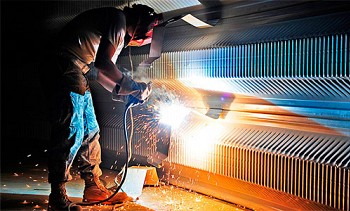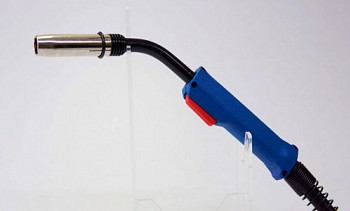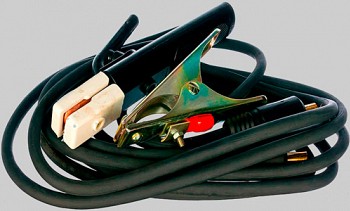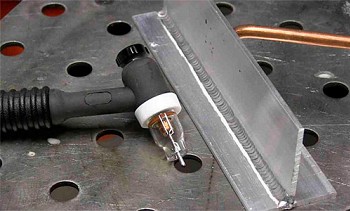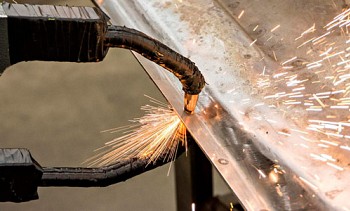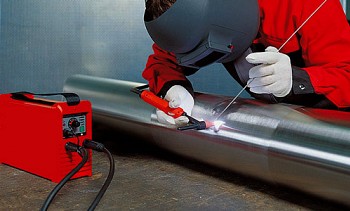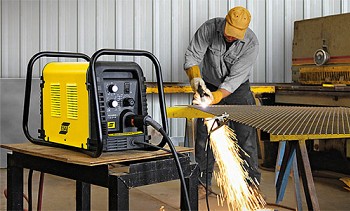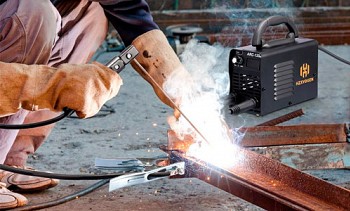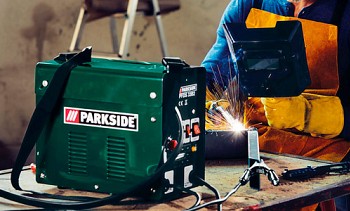Choosing a welding inverter for home and garden - practical tips and examples
In contrast to transformers, inverters are much more compact and consume less voltage, while the quality of the seam is much higher. But the price of such equipment can vary from 3000 to 390000 rubles, so the choice of a welding inverter for a home or other purpose should be made with knowledge of key parameters and their influence on the processes being performed.
This article will help you purchase a machine that is fully consistent with current welding tasks and not overpay for unused functions.
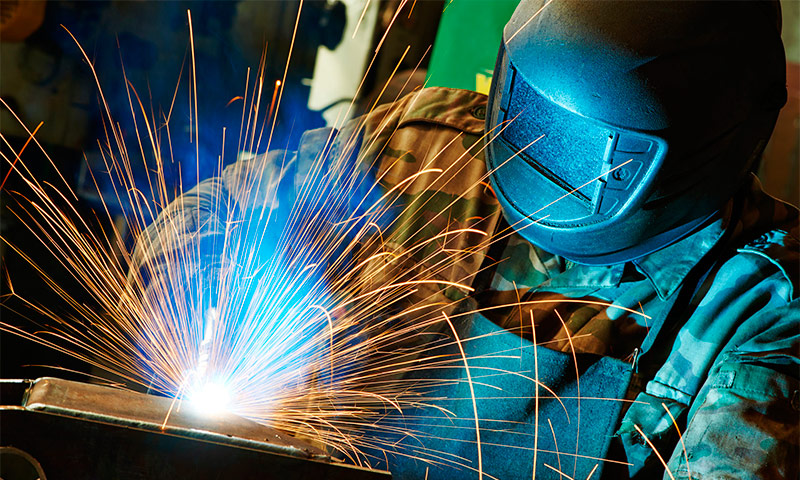
Content:
The device and principle of operation of the welding inverter
Externally, the inverter consists of a power source, ground cables and a holder, a power cord. Welding is possible due to the conversion of current into direct voltage with decreasing volts and increasing amperes, and closing the arc with a temperature of up to 5000 degrees on the product, which melts the edges of the metal and the electrode. Protection against atmospheric effects on liquid metal is achieved by coating the electrode forming a gas insulating cloud.
The inverter housing is equipped with an indication of the operation of the sensors, a current and voltage regulator, jacks for connecting cables, a belt and a transport handle. Mandatory presence of perforations for ventilation. Visual control of the current strength is available on the scale and position of the switch or digital display.
Inside the welding inverter consists of the following parts:
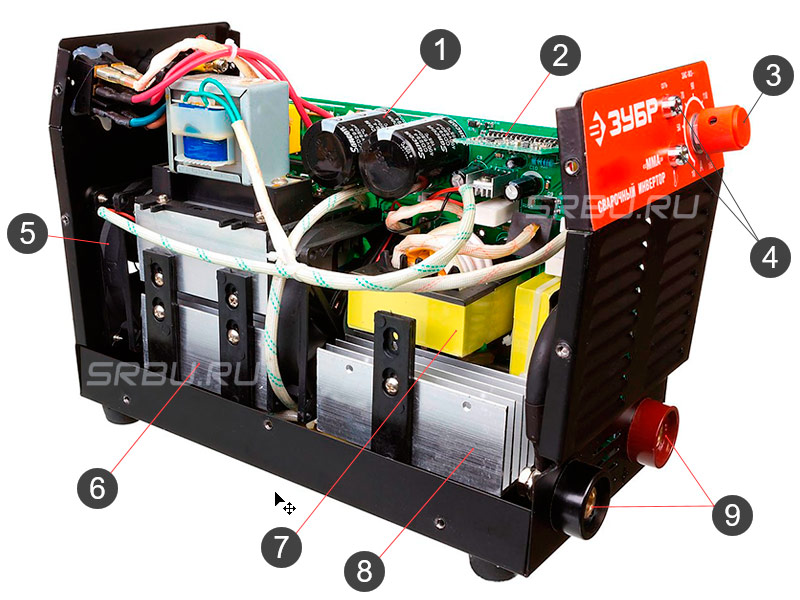
1. Filter Capacitors
2. Pulse Width Modulator.
3. Regulator.
4. Network indicator and overheat indicator.
5. Cooler
6. Transistor Cooling Radiators
7. A step-down transformer.
8. Radiator output rectifier.
9. Output connectors.
In addition, the diagram is not indicated, but in each inverter are used:
- interference filters;
- soft start relay;
- current sensors;
- control circuit with keys;
- integral stabilizer;
- diode bridge;
- network rectifier.
The principle of operation of the inverter is to obtain alternating current from a 220 V / 50 Hz network and convert it to constant. Then it changes back into a variable, but with a frequency of 50-85 kHz. The resulting voltage is reduced on the transformer to 30-90 V, and the current strength on the contrary increases to 20-500 A. At the output, the voltage is rectified again and welding is carried out at direct current with thousands of pulsations.
Such a scheme made it possible to reduce the size of the transformer and significantly reduce the weight of the apparatus. The arc has become much more stable, softer, and molten metal lays more easily and forms into a seam. Many welders note a pleasant rustling when burning an arc, indicating the correct operation of the inverter.
Other advantages of inverters include:
- Economical voltage consumption, cheaper construction or home use.
- Low wiring load, because the power of most devices is in the range of 4-7 kW.
- Support for a large range of current strength for welding thin and thick metals.
- Duration of a working cycle with efficiency up to 95%.
- The ability to weld not only carbon steel, but also alloyed metals, as well as copper and aluminum.
- Reduced spatter during welding.
But devices with inverter technology are much more expensive than transformers. Due to the complex electronic circuit, they need more careful handling and are sensitive to freezing temperatures. In repair they are more complex and costly.
How to choose the right type of welding inverter
To understand how to choose a welding inverter for home and garden, you need to see what technological problems it is able to solve. It depends on the type of device. There are three categories of welding inverters.
MMA
These are simple models that only support manual welding with coated electrodes (RDS). They are best suited for everyday tasks in a private house: weld a canopy on a gate, build a brazier, eliminate a leak in a pipe, make a greenhouse.
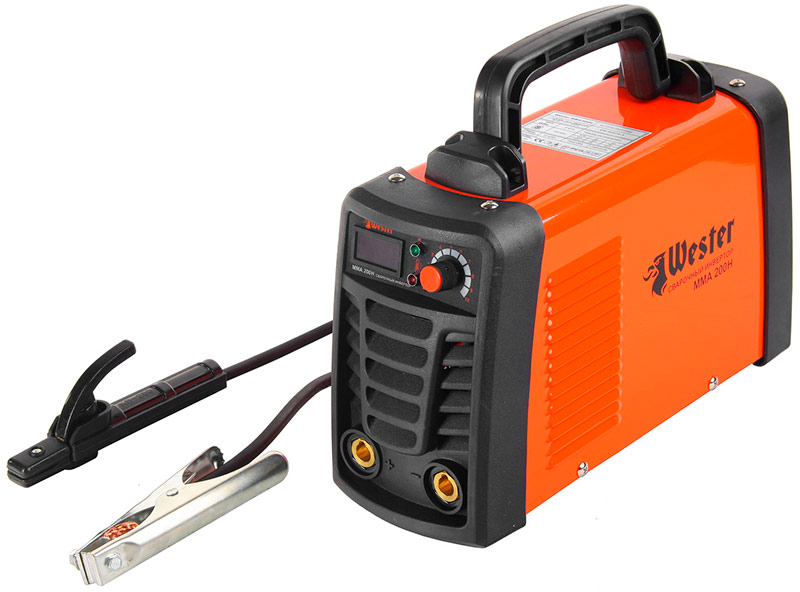
Welding inverter MMA.
MIG / MAG
This is a more advanced category of welding inverters, which, in addition to the electronic unit for converting current, has a mechanical unit for feeding wire from the coil. Instead of short electrodes, which are combustible and require frequent replacement with new ones, the wire is continuously fed into the weld pool through the torch. This ensures long and even seams.
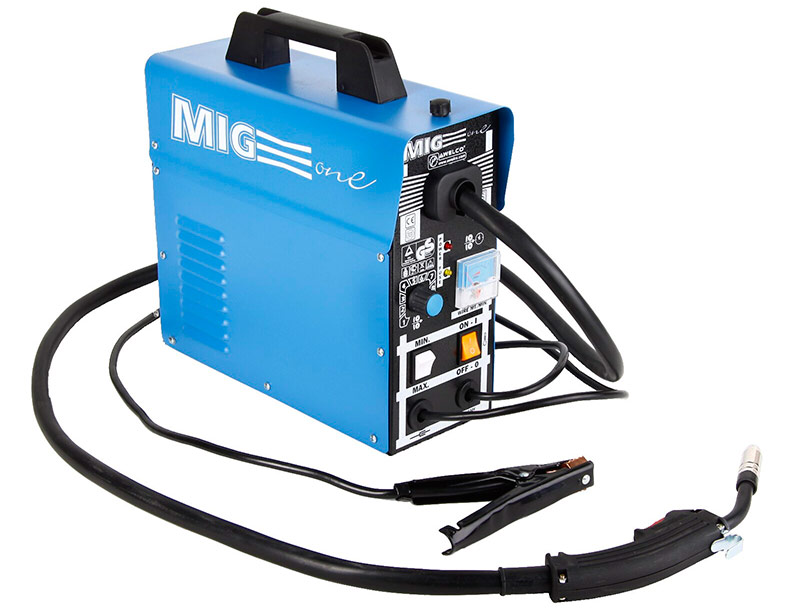
Welding inverter MIG / MAG.
Such devices are chosen for critical connections where productivity and accuracy are important (manufacturing of metal doors and gates, tanks and containers, car body repair). They cost much more, therefore, they are justified only in the case of a small home production. To protect the weld pool, they use an inert gas (carbon dioxide or argon), which is fed along the sleeve of the torch from the cylinder with the gearbox.
MMA / TIG
Such models, in addition to welding with a consumable electrode, have a connector for connecting a burner with gas and a non-consumable rod (tungsten). This allows you to weld very thin metals (from 0.8 mm) with neat seams and even without the use of filler wire (only due to molten edges).
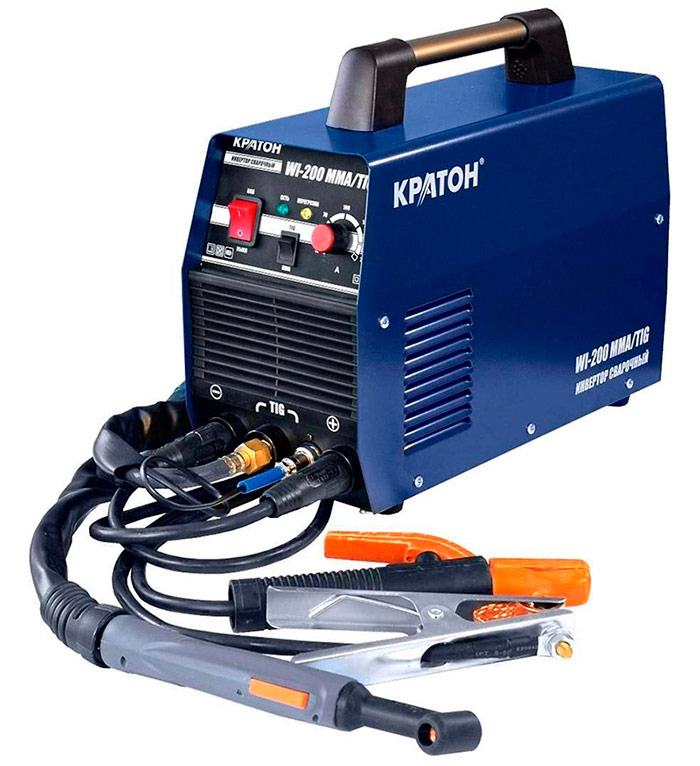
Welding inverter MMA / TIG.
The main advantage of TIG is the ability to brew stainless steel, aluminum and copper. This is practical in the manufacture of towel warmers, repair of radiators, welding cracks in the engine block or gearbox. Such models also need to be equipped with a cylinder and gearbox.
What parameters should be considered when choosing a welding inverter
Before choosing an inverter welding machine, you need to take into account the place of operation (constant or changing), network parameters, upcoming work (metal thickness, number of joints, type of steel, spatial position). All this will help to more accurately understand what characteristics the device should have in order to cope with the tasks.
Here are the key technical data and their relationship with workmanship and job opportunities.
Working voltage
Inverters come with an operating voltage of 220 or 380 V. There are models of a combined type that can switch. For a house and a summer residence, it is better to choose devices for 220 V, since this simplifies connection through a household outlet. They can easily be brought to the place of work by attaching a carrier.
380 V inverters are professional equipment for connecting enterprises. This allows you to get increased power and melt thick metal from 20 mm. If such products often come across in the work and there is a three-phase input in the garage, then it is advisable to choose just such an apparatus.
Models of a combined type are practical for moving activities, when you can cook from 380 V in the workshop, and connect to a household outlet on the road.
In addition to the standard parameters of the operating voltage, you need to choose an inverter according to the input current range. When 220-230 V is stably present in the house, then a model with exactly such characteristics is suitable. But if the voltage often drops in the country house, then the equipment will not be able to give out the required amperage, and sometimes even make welding. Here, the choice is made in favor of inverters capable of cooking with an input voltage of 130-190 V.
Welding Current Adjustment Range
The adjustment range of the welding current affects the thickness of the metal that the machine can handle. Upper and lower bounds are important here. For example, for welding a barbecue made of steel with a thickness of 4 mm, a current strength of 120-160 A is sufficient. Welding the canopy to the gate will turn out with a current of 100-140 A.The same is enough for making a greenhouse or laying a water pipe. An inverter with a maximum current of 160-190 A is suitable here.
But when welding of thick parts (channels, rails) is a priority, or when the inverter is used for cutting in hard-to-reach places, then the current strength of 250-400 A is chosen. There are industrial devices with an indicator of up to 500 A.
The lower limit of the current strength is important when welding thin metals. For example, to make a tank of steel with a thickness of 1.5 mm, you need to lower the current to 45-70 A. When you need to patch up the car body, then use even less current 15-30 A. For this, choose an inverter capable of lowering the amperes to these values.
Another important form of current control, which can be smooth or stepwise. The first changes the readings in increments of 1A, and the second switches at intervals of 10-20 A, depending on the model. When you have to cook the same metals in terms of steel and thickness, then a stepwise adjustment with a large step is enough, because the settings will rarely be accessed. But if the thickness and types of materials often change, then better seams will be obtained on a finely adjustable device that allows you to adapt to a new task.
Duration of inclusion (PV)
Each inverter indicates its turn-on time, indicated in percent, which implies the operating time at maximum current. This indicator varies from 30% to 100%. In practice, this means that a model with a maximum current of 200 A and 30% DC can work 3 minutes out of 10, and then turn off for cooling.
If you need an inverter for small household tasks, then a 30-50% PV is enough. Moreover, such work will not be performed at maximum current, which actually increases the duration of welding up to 5-6 minutes. Since you don’t have to rush here, you should not overpay for more productive models.
But when the priority is the high speed of the work performed (for example, in the manufacture of a tank or doors for sale, where after tacking you can continuously conduct full welding), it is better to choose an inverter with a turn-on time of 60-80%. Moreover, the higher the maximum current strength indicator, the longer it will be possible to carry out work at lower values. For frequent metal cutting, a PV value of 100% is desirable.
Open circuit voltage
Thanks to the inverter transformer, the voltage in it drops to 12 V during welding, which makes it safe for the welder in contact with metal parts. When the arc is not ignited, the open circuit voltage is maintained on the device, varying from 30 to 90 V. When the electrode is brought to the product and the arc is excited, it automatically decreases.
This indicator affects the ease of burning of the electrode. The higher the open circuit voltage, the faster the passage of electricity and the excitation of the arc. This is especially practical when welding rusty metals, which eliminates the need to protect the joint to a shine before seam overlay.
If the inverter is rarely needed and it is not difficult to clean the welding zone, then an open circuit voltage of 30-50 V is sufficient. For an experienced welder this will be the best option. It will be much more difficult for a beginner to grind the electrode, and if the metal is also rusty or contains traces of paint, then it is better to choose an apparatus with an idle speed of 70 V.
Power consumption
This indicator is measured in kW and can be from 4 to 27 units. It implies what kind of load the device will exert on the network when operating at maximum current. For a home, it is better to choose low-power models within 4-6 kW, which does not burn wiring. If a powerful line is laid in the garage and an automatic machine for 16-25 A stands at the entrance, then a more powerful model of 7-9 kW is suitable, which allows boiling metal of greater thickness or cutting. For equipment with 10 kW, connection to a switchboard and three-phase network will be required, which is not applicable everywhere.
The power consumption parameter is relevant in the case of mobile use of the inverter.For this, a gas generator is used, but its output current should cover the needs of the welding machine. Often the capacity of generators reaches 5 kW, therefore, in such limits of power, you need to choose an inverter.
Protection against dust and moisture
The protection of the case against dust and moisture penetration is indicated by the international IP system with numbers from 21 to 23. The first number implies that large objects with a diameter of 12.5 mm or more will not get into the case. This is the standard that protects internal components from being struck by tools or protruding metal structures. Because of this, it is impossible to work near the inverter with a grinder or a drill, because small fractions can easily penetrate into the case and close the contacts.
The second digit means:
- 1 - the inverter is protected from vertical raindrops.
- 2 - the case will not miss the falling drops at an angle of up to 15 degrees.
- 3 - falling spray at an angle of up to 60 degrees will not cause harm.
Since welding operations cannot be carried out in the rain, the degree of protection has a greater effect on whether the apparatus can be maintained if it suddenly rains and welding was carried out in the open air. Those who plan to work in the garage have enough IP21, and for frequent use in the yard or in general in the field with a generator, IP23 is useful.
Ventilation system
To prevent the transformer and diode bridges from overheating, a ventilation system is built into the inverter housing. Its simplest design is a fan and perforation on the housing for air inlet and outlet. Due to this design, internal components are often covered with a layer of dust, which slows down the heat transfer process and requires disassembling the housing and cleaning. But for domestic needs using 1-3 hours a day is enough.
The second type of ventilation system includes a cooler and radiators, and the key components of the inverter are built into the radiators. This helps to take heat more efficiently and remove it outside, but such models cost more. The choice of an inverter with a radiator is justified in case of frequent use of the device at maximum current (welding of thick metals, cutting).
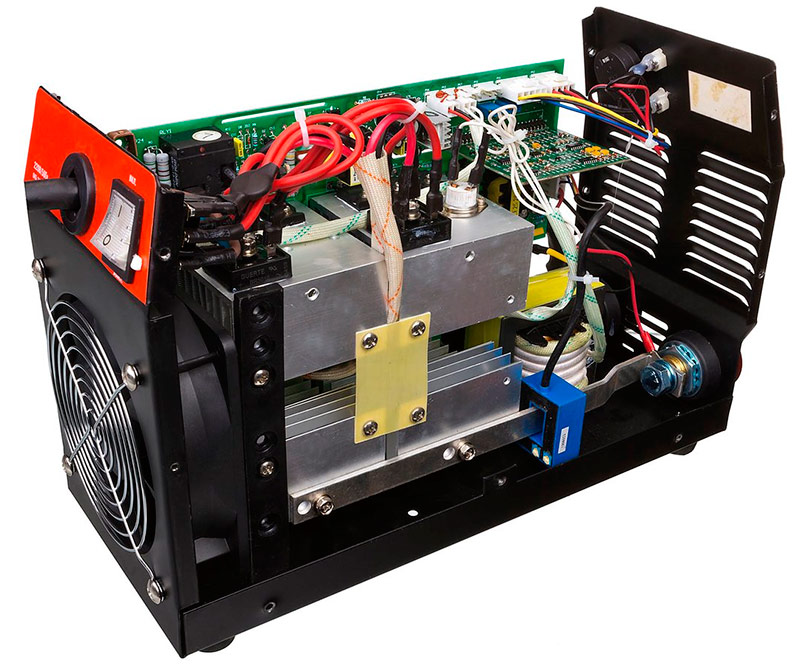
Inverter cooling system with a powerful fan and radiators.
Does the temperature range for operation matter?
Thermal indicators of PV are calculated based on a temperature of +25 degrees. Therefore, in a cooler climate (+10 ... + 15), the devices will be able to work longer. Some reputable manufacturers put in their products a working value of +40 degrees. With positive temperatures, problems rarely arise if the PV and current are correctly selected.
But when working in the cold, electronics can malfunction. For a house or a summer residence, this will not be a problem if welding is carried out in a barn or garage. Any inverter perfectly cooks at a street temperature of +5 degrees. But when suturing is necessary directly in the cold (installation of a fence, gate, welding of farms to mortgages), it is necessary to check the permissible parameters from the manufacturer on the official website (via the contact form), because this is not indicated in the characteristics.
Important weight and dimensions
Despite the much compact dimensions compared to transformers, inverters still have differences in size and weight, due to their power and functionality. Small devices are available with dimensions of 150x200x300 mm, which is well suited for mobile use. They are easy to deliver to the place of work in a special case.
Most models have a strap for hanging on the shoulder, which is convenient for high-altitude work. In this case, their weight varies from 3 to 4.5 kg. But the maximum current strength rarely exceeds 200 A, so they cannot connect too thick steel.
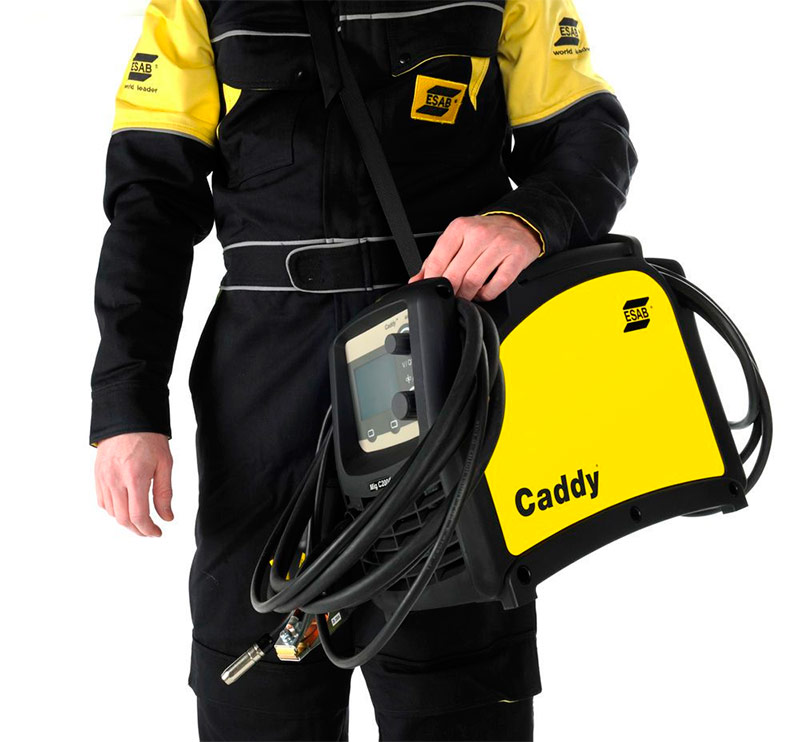
When using an inverter they solve more serious welding problems (assembling a garage frame, cutting), then they use powerful models. Their dimensions can reach 500x200x450 mm, and weight up to 25 kg. For the operation of such equipment, stationary space and long cables will be required to reach the corners of a large structure.Otherwise, you still have to purchase a trolley for transportation, if you do not want to carry it in your hands.
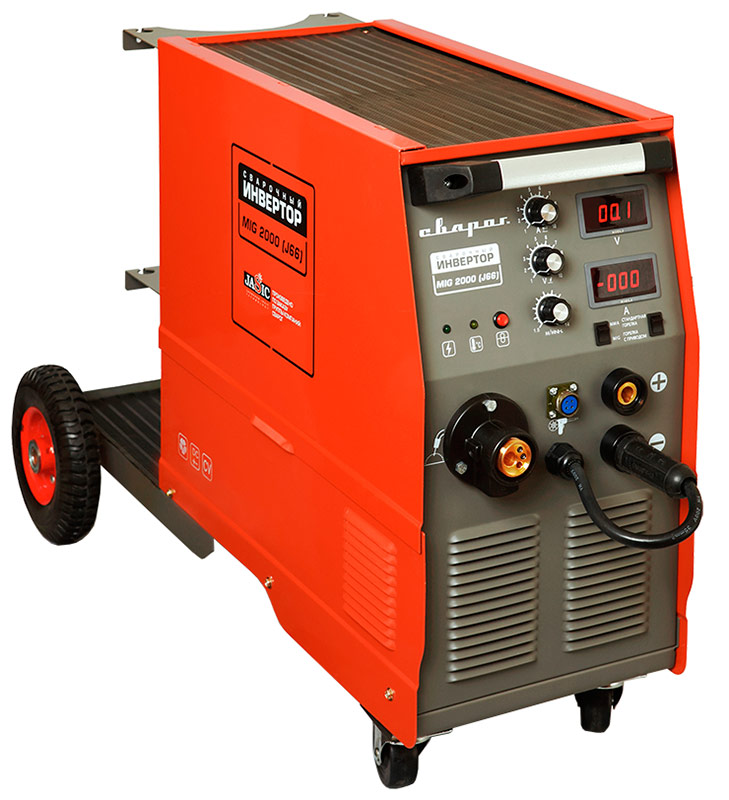
Professional inverter welding machine.
Useful extras
The most inexpensive inverters can only change the current strength and show an indication of the network and overheating. Most often, automation turns off the power when the temperature rises. But to work it was more comfortable or easier, there are several additional functions.
Anti Stick Function
To get an even seam, it is necessary to maintain a clear distance between the end of the electrode and the parts to be welded within 3-5 mm (depending on the current strength). For beginners, this is difficult (the hand has not gotten used to it yet), therefore they often have an electrode sticking to the surface. The function instantly disconnects the voltage and resumes it as soon as contact with the product is broken.
Otherwise, the user has to exert physical force to tear off the end of the filler material, and this leads to sprinkling of the coating.
Hot start function
Practical for welding rusty metals or critical joints. The action of the function is to supply increased voltage (V) at the start of welding, which provides easy ignition and eliminates the need to repeatedly knock the electrode end against the surface. If this is the front side of the part, then the arc will leave fewer marks, which then have to be processed mechanically.
Arc Force Function
Ideal for beginners, who often stick the electrode. An apparatus with this function “senses” the distance between the contacts and when the arc is about to go out, it adds a short-term current strength (A) to prevent this. This action is also useful when welding thin metals (1.0-1.2 mm), since small values (20-40 A) are initially set there, which provokes sticking.
It is better to choose an inverter with a digital display, since the current voltage and amperage are always so visible. The scale drawn is usually small and already from 3-4 meters is difficult to distinguish.
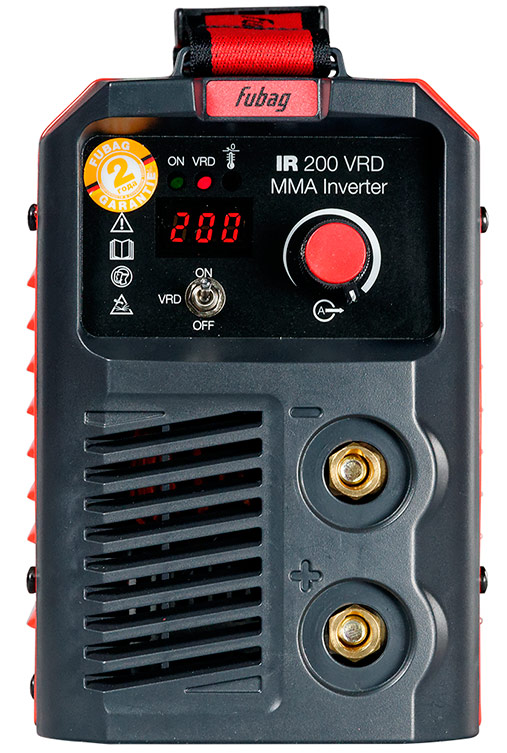
Inverter with electronic display.
If the device is equipped with a connector for TIG welding, then the arc damping function is useful, providing a smooth decrease in amperes when the button is released by the welder. This will prevent the formation of fistulas at the end of the seam and will systematically crystallize the weld pool.
When an inverter apparatus with argon is used for welding large stainless steel tanks or repairing motor housings and gearboxes, the function of remote adjustment of current strength is practical. It is made in the form of a second button on the burner and allows you to adjust the amperes without ever approaching the inverter.
Welding Inverter
Inverters are sold with a mains cable, two 1.5-2 m cables, a mass clamp and a holder. Sometimes this comes with a cheap welding shield and hammer to remove slag. To give this set is enough to cope with current tasks.
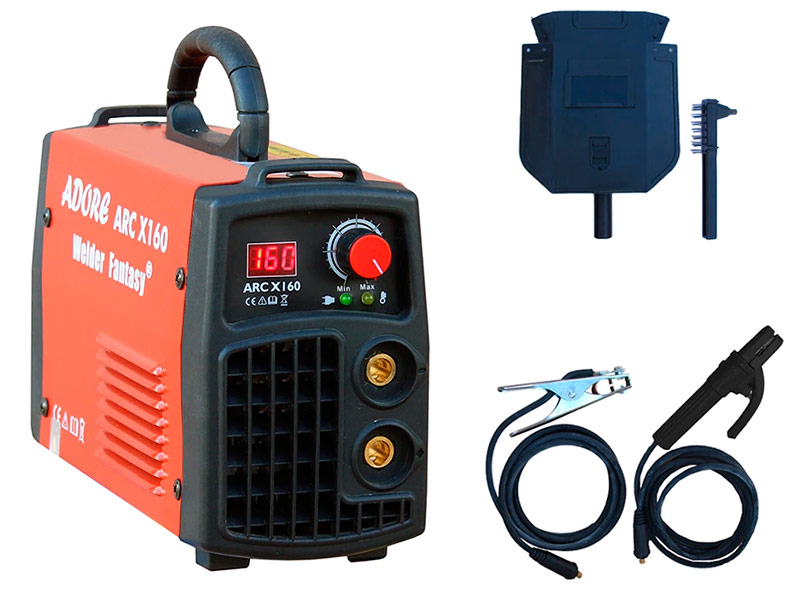
Complete set of the invertor welding machine.
If you need more maneuverability (welding heating in the house, laying water pipes, assembling a high greenhouse), then you will have to buy long cables. You need to choose with a cross section of 16 mm2that will allow them not to overheat and will not create excessive resistance to current. For frequent use, you should buy a mask to put on your head and free your hands. The most convenient model with automatic dimming glass "Chameleon".
When the seam is laid, a hammer is used to separate the slag. Such work is done in safety glasses. For use in the country, when welding in the lower position, gloves from a rough fabric (gaiters) will still be required. When you have to cook vertical or ceiling seams, you need a protective jacket or jumpsuit, as well as special shoes.
With a frequent change of workplace, it is practical to have a case for packing the device (sometimes it is included) and a long carry (5-10 m). If the inverter is equipped with an argon welding connector, then you need to choose a gearbox with high and low pressure, an inert gas cylinder and a hose.
Having a complete understanding of the types and capabilities of inverters, as well as the relationship of their characteristics and the work performed, you can proceed to the selection of welding equipment for specific tasks.

